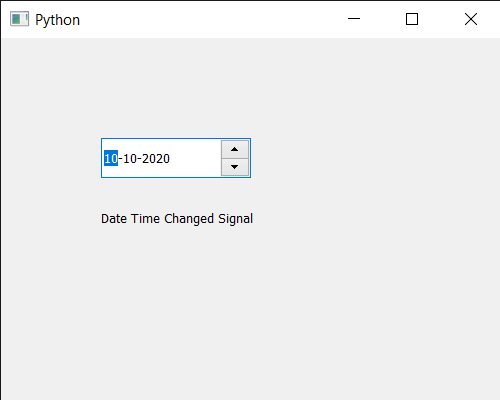En este artículo veremos cómo podemos obtener la señal de cambio de fecha y hora de QDateEdit. A diferencia de la fecha normal, podemos establecer la fecha y hora con la ayuda del setDateTimemétodo. Pero también podemos establecer solo la hora sin cambiar la fecha con la ayuda del setTimemétodo. Esta señal se emite cada vez que se cambia la fecha y la hora de edición de la fecha.
Para hacer esto usamos dateTimeChangedel método con el objeto QDateEdit
Sintaxis: date.dateTimeChanged.connect(método)
Argumento: toma el método como argumento
Retorno : Devuelve Ninguno
A continuación se muestra la implementación.
# importing libraries
from PyQt5.QtWidgets import *
from PyQt5 import QtCore, QtGui
from PyQt5.QtGui import *
from PyQt5.QtCore import *
import sys
class Window(QMainWindow):
def __init__(self):
super().__init__()
# setting title
self.setWindowTitle("Python ")
# setting geometry
self.setGeometry(100, 100, 500, 400)
# calling method
self.UiComponents()
# showing all the widgets
self.show()
# method for components
def UiComponents(self):
# creating a QDateEdit widget
date = QDateEdit(self)
# setting geometry of the date edit
date.setGeometry(100, 100, 150, 40)
# creating a label
label = QLabel("GeeksforGeeks", self)
# setting geometry
label.setGeometry(100, 150, 200, 60)
# making label multiline
label.setWordWrap(True)
# date time change signal
date.dateTimeChanged.connect(lambda: method())
# method called when signal emitted
def method():
# setting text to the label
label.setText("Date Time Changed Signal")
# date time
time = QDateTime(2020, 10, 10, 9, 30)
# setting time
date.setDateTime(time)
# create pyqt5 app
App = QApplication(sys.argv)
# create the instance of our Window
window = Window()
# start the app
sys.exit(App.exec())
Producción :
Publicación traducida automáticamente
Artículo escrito por rakshitarora y traducido por Barcelona Geeks. The original can be accessed here. Licence: CCBY-SA